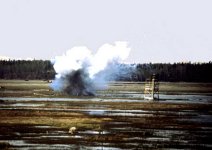THROWN FIRE
names
pyrotechne
tunic
chronic
meat
alchemistry
crude
in law
love's fire
illuminated
tourist
texts
sources
versions
INCENDIARIES
Falarica or fire-bolt: a machine-fired spear with long iron tip dipped in pitch and sulphur.
Fire-darts: hollow cane shafts reinforced with iron, punctured with small holes, filled with bitumen and fired slowly at a target. Flared up on contact with water. Extinguish by smothering in sand.
Chinese fire-lance: bamboo or metal tube packed with sulphur, charcoal, "fire chemical" (saltpetre or nitrate salts - a forerunner of gunpowder)
Roman arrow filled with sulphur, resin, asphalt and pitch, swathed in oakum soaked in crude oil, recommended by Vegetius (400 CE).
GREEK FIRE
heated in a cauldron, and then pumped out by Ktebisios' double-acting piston pump, invented in 200 BCE in Alexandria. later, through a siphon or large syringe, known as a siphonarios, mounted on the bow of the ship; or squirted with hand-syringes (mikroi siphones)
hurled in firepots (grenades, made of earthenware vessels) onto enemy ships. burst into flames on contact. burned on water.
caused panic and dread.
outmoded when new long-range artillery increased the distance at which battles were fought.
pressurized distilled naphtha "clung to everything it touched, instantly igniting any organic material"
hard to control, would often accidentally set Byzantine ships ablaze.
mangonel (from the Arabic manjaniq) was a heavy-duty catapult created for the Umayyad caliph in Damascus. it was used at the siege of Alexandria in 645 CE, and at the attack on Mecca and Medina in 683 CE.
source: Adrienne Mayor, Greek Fire, Poison Arrows, and Scorpion Bombs
source: R. J. Forbes, Bitumen and Petroleum in Antiquity
source: R. J. Forbes, Bitumen and Petroleum in Antiquity, p. 96
WILLY PETE
M722: 60 mm smoke cartridge, weighing 1.68 kg, consisting of detonating fuse and charge of explosive which disperses the phosphorus. range of 3 km. can be fired from mortar at rate of 20 rounds per minute.
M929: 120 mm cartridge, weighing 14 kg, range of 7 km. loaded with felt wedges impregnated with phosphorus.
M198 Howitzer: can fire a 155 mm shell, which delivers 14 kg of phosphorus. M34 hand grenade contians phosphorus, as does the M15, a rifle-launched grenade.
Napalm: E. B. Hershberg designed an ignition system for napalm, based on a rod of high explosive surrounded by WP. The explosive burst the bomb, shattering the WP and scattering the napalm; at the same time, the WP ignited the napalm.
source: Elmsley, The Shocking History p. 157
MILITARY USE
WHITE PHOSPHOROUS
signaling, screening, and incendiary. aid in target location and navigation.
dispersed by explosive munitions. can be fired with fuze time to obtain an airburst.
bursts into yellow flame and produces dense white smoke. luminosity is conveyed to "tracer bullets."

SMOKES
smokes obscure vision and are used to hide troops, equipment, and areas from detection.

"used to destroy the enemy's equipment or to limit his vision. It is used against vehicles, petroleum, oils and lubricants (POL) and ammunition storage areas, and enemy observers."
phosphorus smokes are generated by a variety of munitions. Some of these munitions such as the M825 (155-mm round) may, on explosion, distribute particles of incompletely oxidized white phosphorus.
weight-for-weight, phosphorus is the most effective smoke-screening agent known. It absorbs most of the screening mass from the surrounding atmosphere.

smoke particles are actually an aerosol, a mist of liquid droplets which are close to the ideal range of sizes for Mie scattering of visible light. This effect has been likened to three dimensional textured privacy glass--the smoke cloud does not obstruct an image, but thoroughly scrambles it. It also absorbs infrared radiation.
White Phosphorus and Red Phosphorus burn to produce a hygroscopic smoke containing phosphoric acids. Red phosphorus (RP) is not nearly as reactive as white phosphorus. It reacts slowly with atmospheric moisture and the smoke does not produce thermal injury, hence the smoke is less toxic. The extinction for these smokes is primarily due to scattering in the visible and absorption in the infrared (IR). These smokes are composed of spherical liquid particles that grow with relative humidity to an equilibrium size by absorbing ambient moisture that depends on the ambient relative humidity. The mass extinction varies significantly with relative humidity.
White Phosphorus flame produces a hot, dense white smoke composed of particles of phosphorus pentoxide, which are converted by moist air into phosphoric acid. This acid, depending on concentration and duration of exposure, may produce a variety of topically irritative injuries.
Medical personnel should be prepared to treat potential reactions to military smokes once such smokes have been introduced to the battlefield. Exposure to heavy smoke concentrations for extended periods (particularly if near the source of emission) may cause illness or even death.
source: 'White Phosphorus', Global Security.org
Phosphorus "is used in almost every product imaginable – from soft drinks to toothpaste."
used by industry to produce phosphoric acid and other chemicals for use in fertilizers, food additives, and cleaning compounds. pesticides and fireworks.
phosphates in the production of special glasses, such as those used for sodium lamps.
Bone-ash (calcium phosphate) for fine china and mono-calcium phosphate, used in baking powder.
production of steels, phosphor bronze
trisodium phosphate as cleaning agent, water softener, for preventing boiler scale and corrosion of pipes and boiler tubes.
used in methamphetamine (AKA speed, crank or meth) production by clandestine laboratories.
'profit out of light', motto on display at Bryant and May
source: 'White Phosphorus', Global Security.org